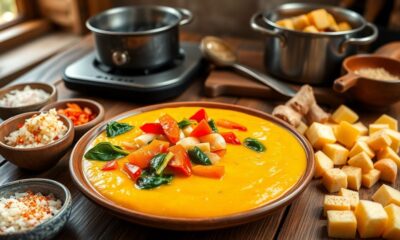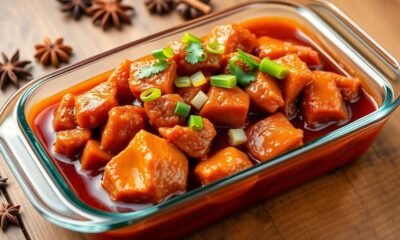Chinese Cuisine
Dumplings (Jiaozi)
Centuries-old Chinese delicacy, dumplings (jiaozi) offer a savory journey through diverse fillings and cooking methods, captivating taste buds with each bite.
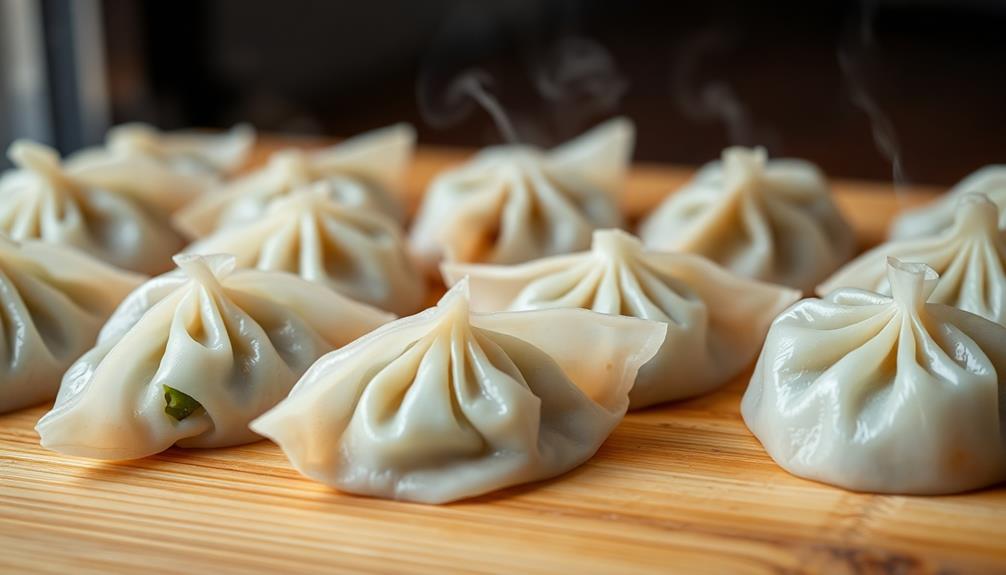
Dumplings, also known as jiaozi, have been loved by the Chinese for centuries! They started as a warming dish during the Han Dynasty and now come in all sorts of savory and sweet fillings. You can pan-fry them for a crispy bottom, boil them for a soft texture, or steam them to keep the flavors fresh. Don't forget the dipping sauces – classic combos like soy sauce, vinegar, and chili oil make the flavors pop. Whether you make them at home or enjoy them at a restaurant, dumplings are a delightful taste of Chinese culture. And there's so much more to discover about these beloved pockets of goodness!
Key Takeaways
- Dumplings have a long history in Chinese culinary tradition, dating back thousands of years to the Han Dynasty.
- Dumplings can be filled with a variety of savory or sweet ingredients and are commonly steamed, boiled, or pan-fried.
- The dough for dumplings requires a precise flour-to-water ratio and kneading to achieve the right texture.
- Dipping sauces, such as soy sauce, vinegar, and chili oil, are essential for enhancing the flavor of dumplings.
- Dumplings are a versatile dish that can be served as a main course, appetizer, or snack.
History
The origins of dumplings, known as jiaozi, can be traced back thousands of years in Chinese culinary history.
These delectable parcels of dough filled with savory or sweet ingredients have been a beloved part of Chinese cuisine since as early as the Han Dynasty.
Legend has it that jiaozi were created by a famous Chinese physician, Zhang Zhongjing, who used them to help warm the bodies of those suffering from the cold.
Over the centuries, the art of dumpling making has been refined, with chefs developing all sorts of creative fillings and intricate folding techniques.
Today, jiaozi are enjoyed throughout China and around the world, from humble homemade versions to elaborate restaurant offerings.
Whether steamed, boiled, or pan-fried, these versatile dumplings continue to delight diners with their comforting flavors and satisfying textures.
Preparing and sharing jiaozi is a beloved cultural tradition that brings families and communities together.
Recipe
Dumplings, also known as jiaozi in Chinese, are a beloved staple in many Asian cuisines. These delectable parcels of dough filled with a savory or sweet mixture are a versatile dish that can be enjoyed as a main course, appetizer, or even a snack. For many, the highlight of a meal featuring dumplings is the delicious soup dumplings recipe. These delicate dumplings are filled with a hot, flavorful broth that bursts in your mouth with each bite. Whether steamed, fried, or boiled, dumplings are always a crowd-pleaser and a must-try for any food lover.
The process of making dumplings from scratch can be a delightful and rewarding experience. The dough, which is typically made from flour, water, and sometimes eggs, is rolled out and cut into small circles. The filling, which can consist of a variety of ingredients such as ground meat, vegetables, or seafood, is then placed in the center of the dough circles, and the dumplings are carefully folded and sealed.
Ingredients:
- 2 cups all-purpose flour
- 3/4 cup warm water
- 1/2 teaspoon salt
- 1 pound ground pork (or a mixture of ground pork and beef)
- 1 cup shredded cabbage
- 2 cloves garlic, minced
- 1 tablespoon soy sauce
- 1 teaspoon sesame oil
- 1/4 teaspoon white pepper
Cooking Instructions:
In a large mixing bowl, combine the flour and salt. Gradually add the warm water and knead the dough until it becomes smooth and elastic. Cover the dough and let it rest for 30 minutes.
In a separate bowl, mix together the ground meat, cabbage, garlic, soy sauce, sesame oil, and white pepper. To assemble the dumplings, roll the dough into thin circles and place a spoonful of the filling in the center. Fold the dough over and crimp the edges to seal the dumplings.
Bring a large pot of water to a boil, then add the dumplings and cook for 8-10 minutes, or until they float to the surface. When cooking dumplings, it's important to work in batches and not overcrowd the pot.
Serve the dumplings hot, with your choice of dipping sauces such as soy sauce, vinegar, or chili oil. Enjoy the delightful combination of the tender dough and the flavorful filling!
Cooking Steps
Mix up the filling ingredients until they're well combined.
Roll out the wrappers into thin, round shapes.
Pleat and seal the dumplings, then boil 'em until they're cooked through.
Serve 'em up with a tasty dipping sauce – yum!
Step 1. Mix Filling Ingredients
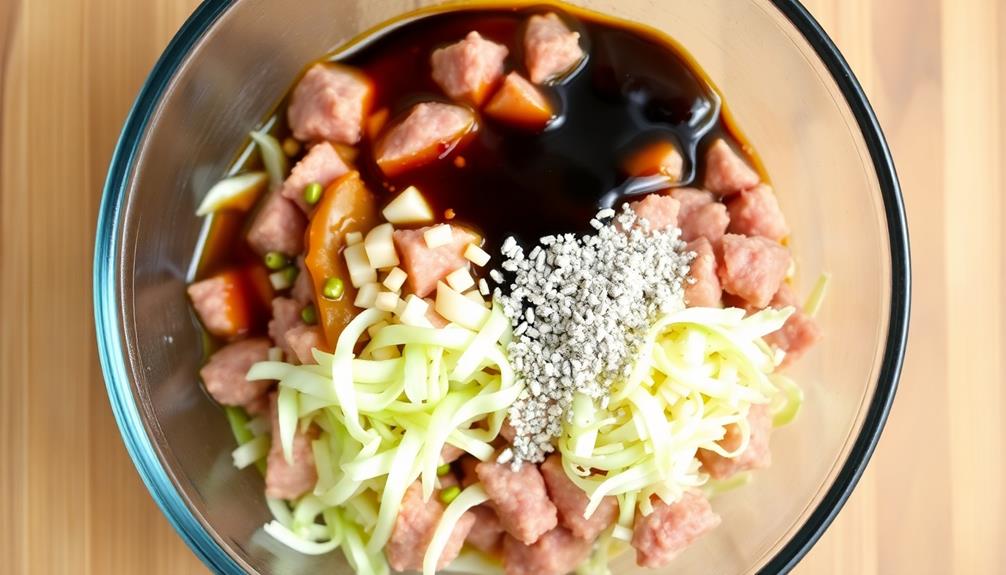
With your hands, gently combine the filling ingredients in a large bowl. First, add the ground pork or ground chicken, then sprinkle in the finely chopped cabbage, scallions, and ginger.
Don't be afraid to get in there with your fingers! Gently mix everything together until the filling has a nice, even consistency. You'll want to make sure all the ingredients are evenly distributed.
Next, crack an egg into the bowl and use a fork to lightly beat it before folding it into the filling. This will help bind everything together.
Finally, add a dash of soy sauce, a pinch of salt, and a sprinkle of white pepper. Give the whole mixture one more gentle stir to incorporate all the flavors.
Your filling is now ready to be scooped into the dumpling wrappers. Isn't that easy? With just a few simple steps, you've created the perfect dumpling filling.
Now, let's move on to shaping those delicious dumplings!
Step 2. Roll Out Wrappers
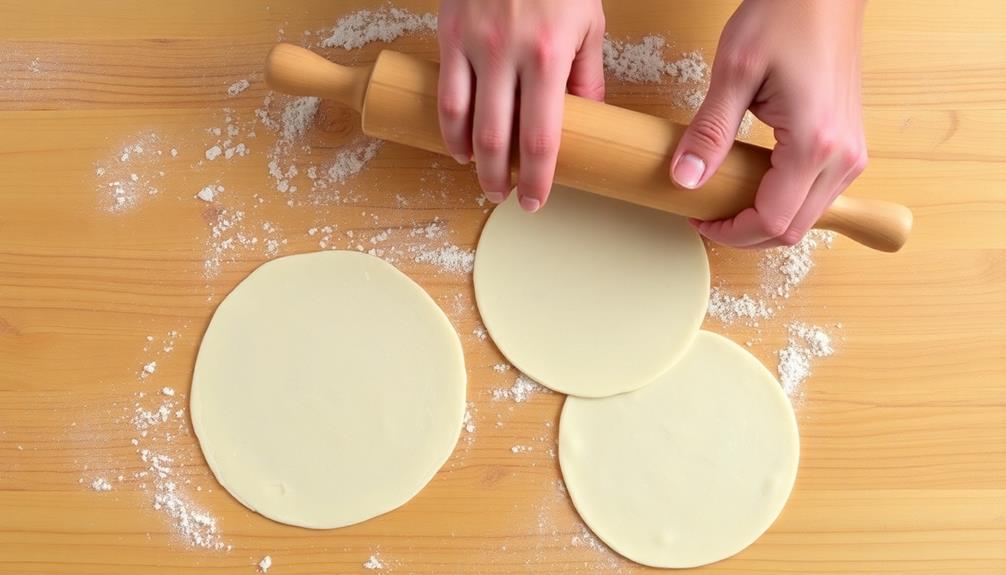
To roll out the wrappers, you'll need a clean, lightly floured surface. Start by dividing the dough into smaller pieces, about the size of a golf ball.
Using a rolling pin, gently roll each piece into a thin, round wrapper, being careful not to let the dough stick to the surface. Flip and rotate the dough as you go, adding a sprinkle of flour if needed. Aim for a wrapper that's about 4 inches in diameter and paper-thin.
Don't worry if they're not perfectly round – the irregular shapes will add character to your dumplings!
Once you've rolled out all the wrappers, cover them with a damp cloth to prevent them from drying out while you fill and fold them.
With a little practice, you'll be rolling like a pro in no time. Just take it slow, and enjoy the satisfying process of crafting each wrapper by hand.
Step 3. Pleat and Seal Dumplings
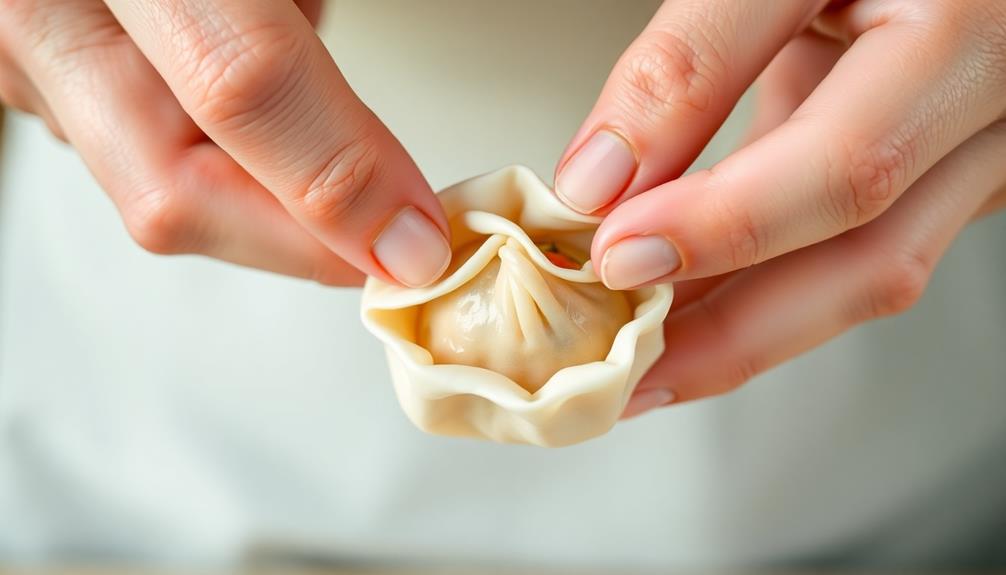
Now that you have your delicate wrappers ready, let's dive into the process of pleating and sealing the dumplings.
First, place a spoonful of your desired filling in the center of the wrapper. Make sure not to overstuff, as this can cause the dumplings to burst during cooking.
Next, wet the edges of the wrapper with a bit of water, using your finger or a brush. This will help the dumplings seal securely.
Fold the wrapper in half, creating a crescent shape. Start pleating the edges by pinching and folding the dough, working your way around the half-moon. Aim for 3-5 pleats on each side, depending on the size of your wrappers.
Press firmly to seal the dumplings, ensuring there are no gaps or air pockets.
Once pleated, place the dumplings on a lightly floured surface or baking sheet, keeping them separate to prevent sticking.
Now you're ready to cook your delicious homemade dumplings! Get ready for a tasty and satisfying meal.
Step 4. Boil Dumplings Until Cooked Through
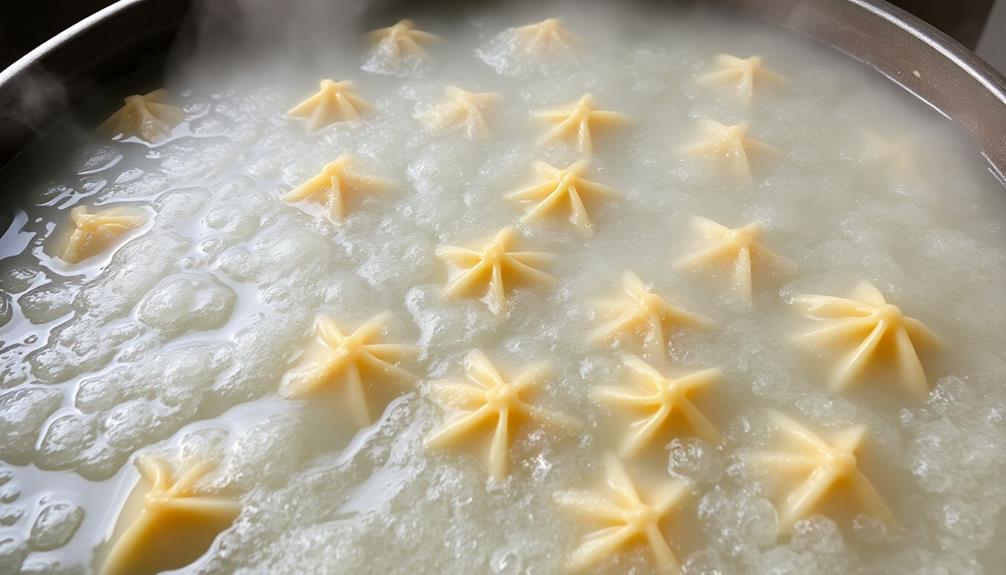
Bring a large pot of salted water to a rapid boil.
Once it's bubbling vigorously, gently place your plump, pleated dumplings into the pot. They'll need about 8-10 minutes to cook through completely.
You'll know they're done when they float to the surface and the dough turns translucent. Resist the urge to peek – opening the lid can cause the dumplings to fall apart!
Instead, use a slotted spoon to scoop them out one by one, draining off any excess water. Serve the piping hot dumplings immediately, being careful not to burn your tongue.
Dip them in your favorite sauce, like soy sauce, vinegar, or chili oil, for a tasty flavor boost. The fluffy, juicy filling contrasts perfectly with the slightly chewy wrapper.
Enjoy these comforting dumplings as a snack or light meal. Just don't forget to save room for seconds!
Step 5. Serve With Dipping Sauce
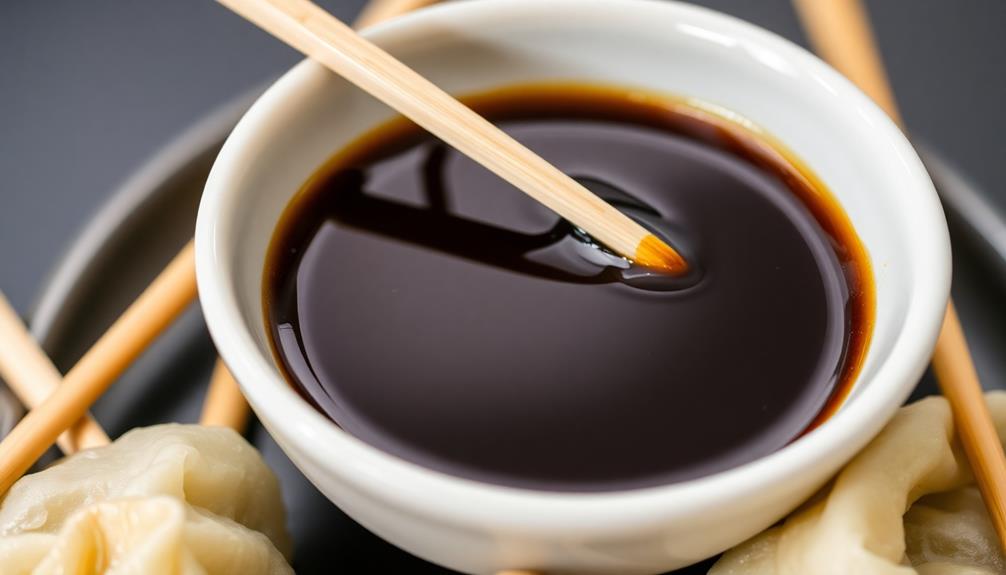
After draining the cooked dumplings, it's time to serve them with a delicious dipping sauce. You'll want to prepare a simple sauce that complements the savory flavors of the dumplings. A classic choice is a mixture of soy sauce, rice vinegar, and a touch of sesame oil. Simply combine these ingredients in a small bowl and give it a good stir.
For an extra flavor boost, you can add a bit of minced garlic, ginger, or even a sprinkle of crushed red pepper flakes. The great thing about dipping sauces is that you can easily customize them to suit your personal taste preferences. If you like things a little sweeter, try adding a teaspoon of honey or brown sugar.
Once your sauce is ready, arrange the dumplings on a serving plate and invite your family and friends to dip away! The combination of the tender dumplings and the zesty, flavorful sauce is absolutely irresistible.
Enjoy every delicious bite!
Final Thoughts
Ultimately, how do you feel about the versatile and delectable dish of dumplings?
You've learned so much about these tasty parcels – from how to make the perfect dough to whipping up a variety of savory and sweet fillings.
And of course, you can't forget the all-important dipping sauces that take dumplings to the next level.
Whether you prefer to pan-fry, boil, or steam them, dumplings are a wonderfully satisfying meal that the whole family will enjoy.
Don't be afraid to get creative and experiment with new flavors. Who knows, you might just discover your new favorite variety!
The best part is, dumplings are easy to make and can be prepared in big batches, so you can always have some on hand for a quick and delicious snack or meal.
Frequently Asked Questions
What Is the Nutritional Value of Dumplings?
The nutritional value of dumplings can vary, but they typically provide carbohydrates, protein, and some vitamins and minerals. The exact nutritional profile depends on the ingredients used, so you'll want to check the specific recipe or nutrition label.
How Long Do Dumplings Last in the Refrigerator?
Properly stored, dumplings can last 3-4 days in the refrigerator. Make sure to keep them in an airtight container and consume them within that timeframe for best quality and safety.
Can Vegetarians/Vegans Enjoy Dumplings?
Yes, vegetarians and vegans can certainly enjoy dumplings! Many dumpling recipes use plant-based ingredients, and you can find delicious vegetarian or vegan dumpling options at specialty stores or by making them yourself.
How Can I Customize the Filling Ingredients?
You can customize the filling ingredients to suit your dietary preferences. Try using a variety of vegetables, tofu, mushrooms, or plant-based proteins to create delicious and satisfying vegan or vegetarian dumplings.
What Are the Best Dipping Sauces for Dumplings?
The best dipping sauces for dumplings are typically soy sauce, chili oil, black vinegar, and minced garlic. You can also experiment with peanut sauce, scallion-ginger sauce, or a blend of these flavors to complement the dumplings' taste.
Li Wei is an authentic Chinese cooking expert specializing in regional and classic Chinese dishes. From hand-pulled noodles to delicate dim sum and traditional stir-fries, his culinary expertise showcases the variety of Chinese cuisine. Li Wei’s recipes emphasize simplicity, tradition, and rich, flavorful sauces.
Chinese Cuisine
Yunnan Cross-Bridge Rice Noodles
Nestled in the heart of Yunnan, China, Yunnan cross-bridge rice noodles offer a mouthwatering journey through the province’s rich culinary heritage, leaving you craving for more.

Yunnan cross-bridge rice noodles are a mouthwatering dish hailing from the vibrant province of Yunnan, China. Tracing their roots to the late Qing dynasty, these noodles were accidentally created by Yunnanese scholars crossing the Long Bridge over the Yangtze River. Today, this UNESCO-recognized culinary treasure features a unique cooking method – you'll assemble the ingredients, then pour in hot, flavorful broth to create an unforgettable dining experience. Get ready to dive into tender rice noodles, fresh veggies, and succulent proteins, all expertly blended for a true taste of Yunnan's rich heritage. The versatility of Yunnan cross-bridge rice noodles reflects the region’s culinary diversity, with each bowl offering a comforting yet customizable experience. Much like **yangzhou fried rice ingredients**, which can vary but commonly include shrimp, char siu pork, peas, and eggs, the beauty of this dish lies in the freedom to choose your own medley of vegetables, meats, and toppings. Whether enjoyed in a local eatery or prepared at home, each bowl promises a delightful fusion of flavors, paying homage to Yunnan’s storied gastronomic traditions.
Key Takeaways
- Yunnan Cross-Bridge Rice Noodles have their origins in the late Qing dynasty of Yunnan province, created by Yunnanese scholars crossing the Long Bridge over the Yangtze River.
- This noodle dish is recognized as a UNESCO intangible cultural heritage, representing the rich heritage and culinary traditions of Yunnan province.
- The unique cooking method involves assembling ingredients and pouring hot broth over them, creating a multi-textural dining experience with robust flavors.
- Yunnan Cross-Bridge Rice Noodles are traditionally served at family gatherings and celebrations, reflecting the dish's cultural significance and symbolism of hospitality.
- The dish features a flavorful broth, chewy rice noodles, fresh vegetables, and various proteins, offering a balanced and customizable nutritional profile.
History
The origins of Yunnan cross-bridge rice noodles can be traced back to the late Qing dynasty, when Yunnan province's diverse culinary traditions began to take shape.
This unique dish was created by a group of diligent Yunnanese scholars who'd often carry their lunch with them as they crossed the Long Bridge over the Yangtze River. One day, as they were eating, the noodles fell into the hot soup below – and a tasty new dish was born!
The scholars quickly realized that submerging the noodles in the hot broth was actually the key to the dish's delectable flavor. The heat softened the rice noodles while infusing them with the rich, aromatic broth.
Over time, cross-bridge noodles became a beloved specialty in Yunnan, known for their springy texture and mouthwatering savory notes.
Today, this centuries-old recipe is still prepared with care, using fresh regional ingredients that celebrate Yunnan's vibrant culinary heritage.
Recipe
Yunnan cross-bridge rice noodles, also known as "Crossing the Bridge" noodles, is a popular dish originating from the Yunnan province in China. This dish is renowned for its flavorful broth and chewy rice noodles. The unique cooking method involves carefully assembling the ingredients and pouring hot broth over them, creating a visually stunning and delicious meal.
The dish is typically served family-style, with the broth and noodles presented separately, allowing each diner to customize their bowl to their liking. The process of "crossing the bridge" refers to the tradition of the chef bringing the hot broth to the table, creating a sense of anticipation and theater.
Ingredients:
- 8 oz rice noodles
- 4 cups chicken or vegetable broth
- 1 lb boneless, skinless chicken thighs, thinly sliced
- 2 eggs, beaten
- 1 cup thinly sliced cabbage
- 1 cup bean sprouts
- 1/2 cup thinly sliced green onions
- 2 cloves garlic, minced
- 1 tbsp soy sauce
- 1 tsp sesame oil
- 1/2 tsp white pepper
Cooking Instructions:
In a large pot, bring the broth to a boil. Reduce heat to low and keep the broth at a gentle simmer.
Arrange the chicken, eggs, cabbage, bean sprouts, and green onions on a serving platter. Serve the hot broth, noodles, and garnishes separately, allowing each diner to customize their bowl.
When cooking this dish, it's important to slice the ingredients thinly to ensure quick cooking and easy assembly. Additionally, make sure the broth is piping hot when served, as the contrast between the hot broth and the fresh, cool ingredients is a key part of the experience.
Enjoy your Yunnan cross-bridge rice noodles!
Cooking Steps
Soak those rice noodles in water until they're nice and soft.
Once the broth's bubbling away, you can start arranging everything – the noodles, the broth, and all the tasty toppings.
Don't forget to add your favorite fixings, then serve it up piping hot for the best slurping experience!
Step 1. Soak Rice Noodles in Water

Grab a large bowl and fill it with lukewarm water. This is where you'll soak your rice noodles to get them nice and soft.
Make sure the water covers the noodles completely, as they'll expand as they soak. Give the noodles about 20-30 minutes to soak, stirring them occasionally to ensure even softening. You'll know they're ready when they've become pliable and easy to bend without breaking.
Once the noodles have soaked, drain them in a colander. Rinse them under cool running water to remove any excess starch.
This step helps prevent the noodles from sticking together later on. Gently squeeze out any excess water, being careful not to damage the delicate noodles.
Now they're all set to be added to your hot broth or stir-fried dishes! Get ready to enjoy the chewy, slurpable goodness of your Yunnan cross-bridge rice noodles.
Step 2. Bring Broth to a Boil

Next, bring a large pot of broth to a rolling boil. This'll be the key to unlocking the mouthwatering flavors of your Yunnan cross-bridge rice noodles.
Make sure to use a generous amount of broth – you want enough to fully submerge the noodles. As the broth heats up, you'll start to see those lively bubbles burst on the surface. That's your cue that it's ready!
Don't be afraid to crank up the heat to get it going. Once it's at a full boil, you can reduce the heat slightly to maintain that steady simmer.
Now, grab your soaked rice noodles and gently add them to the hot broth. Stir them around to make sure they're fully submerged and separated.
Let the noodles cook for just a minute or two until they're tender and pliable. You want them to have a nice bite, not be mushy.
With the broth boiling and the noodles ready, you're one step closer to slurping up a delicious bowl of Yunnan goodness!
Step 3. Arrange Noodles, Broth, and Toppings

With the broth at a rolling boil and the noodles ready, it's time to assemble your Yunnan cross-bridge rice noodle dish.
First, grab a large bowl and carefully pour in some of the steaming hot broth.
Now, use your chopsticks to gently lower the freshly cooked noodles into the broth. Arrange them neatly, making sure they're fully submerged.
Next, it's time for the fun part – adding your favorite toppings! You can load up your bowl with slices of tender beef, juicy chicken, or crisp veggies like baby bok choy.
Don't forget to sprinkle on some chopped scallions and cilantro for extra flavor and color.
Finally, give everything a gentle stir to combine the ingredients.
Your Yunnan cross-bridge rice noodle masterpiece is now ready to enjoy! The hot, fragrant broth, chewy noodles, and tasty toppings make for a truly delightful and satisfying meal.
Step 4. Add Desired Toppings

With the noodles and broth ready, you can now start adding your desired toppings. The fun part is choosing all the tasty treats to top off your bowl!
First, you'll want to add some fresh, crunchy vegetables like thinly sliced cabbage, carrot, and green onion. These add great texture and flavor.
Next, consider adding a protein like roasted chicken, beef, or even soft-boiled eggs for extra heartiness.
Don't forget the herbs – fresh cilantro, mint, and Thai basil will really make the dish pop with their aromatic flavors.
For a bit of crunch, try topping it off with crispy wonton strips or peanuts.
Finally, a drizzle of chili oil or sriracha will give it a delightful kick of heat.
Get creative and customize your bowl exactly how you like it! With all these amazing toppings, your Yunnan Cross-Bridge Rice Noodles are about to be taken to the next level of deliciousness.
Step 5. Serve Immediately, While Hot

Once the noodles and toppings are ready, serve the dish immediately while it's hot. The steaming broth, tender noodles, and aromatic toppings are at their best when enjoyed right away.
Don't let the food cool down – dive in and savor every delicious bite!
Transfer the noodles and toppings to a big bowl, then ladle the hot broth over the top. The noodles will soak up the flavorful liquid, creating a comforting and satisfying meal.
Make sure to include all your favorite toppings for the ultimate Cross-Bridge Rice Noodle experience.
As you take that first slurpy spoonful, you'll be transported to the bustling markets of Yunnan. The combination of textures and flavors is simply irresistible.
Final Thoughts
As you've explored the depths of Yunnan's renowned cross-bridge rice noodles, it's clear that this culinary delight offers a unique and captivating dining experience.
From the artful preparation to the robust flavors, every bite transports you to the heart of this vibrant region. What truly sets these noodles apart is the dedication and passion of the chefs who've perfected the craft over generations. The spicy dan dan noodles recipe is a shining example of their expertise, with its balance of heat and savory flavors. Each bowl is a homage to tradition, a testament to the artistry and skill passed down through the years. With every mouthful, you can taste the history and culture of this celebrated dish.
As you reflect on your journey through this culinary adventure, take a moment to savor the memories.
Picture the steaming bowls, the aromatic broth, and the interplay of textures that make each mouthful a delightful discovery.
This is more than just a meal – it's a cultural experience that celebrates the rich heritage of Yunnan and the enduring power of food to bring people together.
Frequently Asked Questions
Can the Noodles Be Made With Different Types of Rice?
You can certainly use different types of rice to make rice noodles. The choice of rice variety will affect the texture and flavor, so experiment to find the one that suits your preferences best.
How Long Do the Noodles Typically Last After Being Cooked?
How long do the cooked noodles typically last? Well, it depends on the type of noodles, but generally, they'll stay fresh for 3-5 days when stored properly in the fridge. Just be sure to keep 'em covered to prevent drying out.
Are There Any Dietary Restrictions Associated With This Dish?
Regarding dietary restrictions, the dish may not be suitable for individuals with gluten or nut allergies. It's always best to inquire about the specific ingredients used to ensure it aligns with your dietary needs.
Can the Toppings Be Customized to Individual Preferences?
You can customize the toppings to your individual preferences. The dish is highly versatile, allowing you to tailor the ingredients to your liking and dietary needs. You have the freedom to create a personalized version of this dish.
Are There Any Health Benefits to Consuming Yunnan Cross-Bridge Rice Noodles?
When you consume rice noodles, you can enjoy some health benefits. They're typically low in fat and calories, and provide complex carbs that can fuel your body. Plus, they're gluten-free, making them a great option for those with dietary restrictions.
Li Wei is an authentic Chinese cooking expert specializing in regional and classic Chinese dishes. From hand-pulled noodles to delicate dim sum and traditional stir-fries, his culinary expertise showcases the variety of Chinese cuisine. Li Wei’s recipes emphasize simplicity, tradition, and rich, flavorful sauces.
Chinese Cuisine
Red-Braised Pork Belly
A succulent Hunan classic, red-braised pork belly is a melt-in-your-mouth delight that has captivated generations, with its rich soy and brown sugar flavors. Discover the secrets behind this…
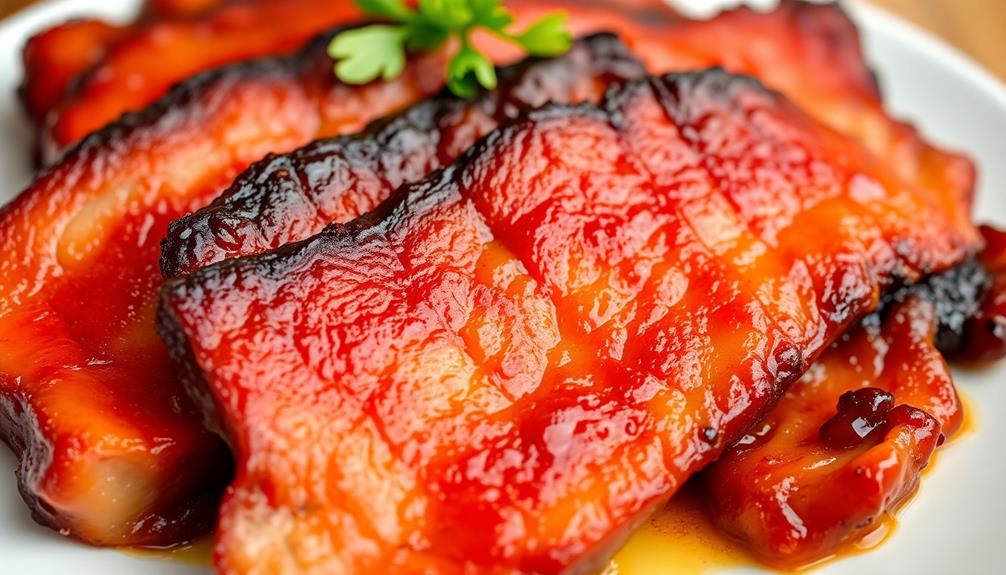
Red-braised pork belly is a scrumptious Chinese dish from Hunan Province that's been passed down for generations. You'll start by searing the pork to get a mouthwatering crust, then simmer it in a rich soy and brown sugar sauce with fragrant spices like star anise and cinnamon. The long, slow cooking makes the pork belly melt-in-your-mouth tender. Garnish it with fresh green onions for a pop of color and crunch. Serve this comforting dish with steamed rice, and you'll see why it's considered a true culinary treasure. Want to learn more about the storied history and cooking techniques behind this irresistible dish?
Key Takeaways
- Red-Braised Pork Belly is a traditional Chinese dish originating from Hunan province, known for its savory, sweet, and aromatic flavors.
- The recipe features tender pork belly simmered in a rich sauce with key ingredients like soy sauce, rice wine, and brown sugar.
- Cooking techniques such as blanching, searing, and long braising are essential for achieving the desired tenderness and flavor complexity.
- The harmonious balance of flavors and textures, including the tender pork and the crunchy green onion garnish, creates an irresistible culinary experience.
- Patience and skill development are crucial in preparing this dish, as it can be improved by allowing the flavors to meld over time.
History
The origins of red-braised pork belly can be traced back to the Hunan province of China, where this savory and aromatic dish has been a beloved regional delicacy for centuries.
The heart of this classic recipe lies in the slow-cooking process, which allows the pork's natural flavors to mingle with the rich, caramelized sauce. As the pork simmers away, the fat renders down, creating a melt-in-your-mouth texture that's simply irresistible.
Over time, the dish has become a beloved part of Chinese culinary heritage, with families passing down their cherished techniques and secret ingredients from generation to generation.
Whether enjoyed as a family meal or a special occasion feast, red-braised pork belly remains a beloved staple that continues to delight taste buds across China and beyond. Red-braised pork belly, also known as “hong shao rou” in Mandarin, is a classic Chinese cuisine delicacy that is characterized by its rich, savory flavor and melt-in-your-mouth tenderness. The dish is often prepared by braising thick slices of pork belly in a flavorful mixture of soy sauce, ginger, garlic, and spices until the meat is succulent and the sauce has thickened to a luxurious glaze. Its popularity extends beyond China, as food enthusiasts around the world are drawn to its irresistible combination of sweet, savory, and umami flavors.
Its captivating combination of savory, sweet, and aromatic notes makes it a true culinary treasure, steeped in the rich traditions of Chinese cuisine.
Recipe
Red-Braised Pork Belly is a classic Chinese dish that features tender, flavorful pork belly slowly simmered in a rich, savory sauce. The long braising time allows the pork to become meltingly tender, while the aromatic spices and soy sauce infuse the meat with deep, complex flavors.
The key to the perfect red-braised pork belly is patience. The dish requires a bit of time and attention, but the results are well worth it. The pork belly is first seared to create a golden-brown crust, then simmered in a mixture of soy sauce, rice wine, and spices until the meat is fall-apart tender.
- 2 lbs pork belly, cut into 1-inch cubes
- 3 cloves garlic, minced
- 1 inch ginger, peeled and sliced
- 1/2 cup soy sauce
- 1/4 cup rice wine or Shaoxing wine
- 2 tablespoons brown sugar
- 2 star anise
- 2 cinnamon sticks
- 4 cups chicken or beef stock
In a large Dutch oven or heavy-bottomed pot, sear the pork belly over medium-high heat until golden brown on all sides, about 5-7 minutes. Remove the pork from the pot and set aside.
Reduce the heat to medium, add the garlic and ginger to the pot, and cook for 1-2 minutes until fragrant. Pour in the soy sauce, rice wine, brown sugar, star anise, and cinnamon sticks, and stir to combine.
Add the seared pork belly and stock, and bring the mixture to a boil. Reduce the heat to low, cover the pot, and simmer for 2-3 hours, or until the pork is tender and the sauce has thickened. Adjust the seasoning to taste, and serve the red-braised pork belly with steamed rice, a side of vegetables, and your favorite condiments.
For the best results, be patient and let the pork braise for as long as possible. The longer it cooks, the more tender and flavorful the pork will become.
Additionally, you can prepare the dish a day in advance and let the flavors meld together overnight before reheating and serving.
Cooking Steps
Slice that pork belly into chunky pieces, then blanch them in boiling water to get rid of any impurities.
Next, you'll caramelize the pork in a skillet to lock in the flavor.
Step 1. Slice Pork Belly Into Chunks

Before you can begin cooking the pork belly, you'll need to slice it into bite-sized chunks. First, grab a sharp knife and a sturdy cutting board.
Carefully place the pork belly on the board, then use the knife to cut the meat into 1-inch pieces. Don't worry if they're not perfectly uniform – the irregular shapes will add to the rustic charm of the dish.
As you work, try to keep the pieces evenly sized so they cook at the same rate. Once you've sliced the entire pork belly, you can give the chunks a quick rinse under cold water to remove any stray bits of fat or skin.
Dry them off with some paper towels, and you're ready to move on to the next step! Cooking the pork belly low and slow is the key to achieving that melt-in-your-mouth texture, so take your time and enjoy the process.
Your patience will definitely pay off in the end.
Step 2. Blanch Pork Belly in Boiling Water
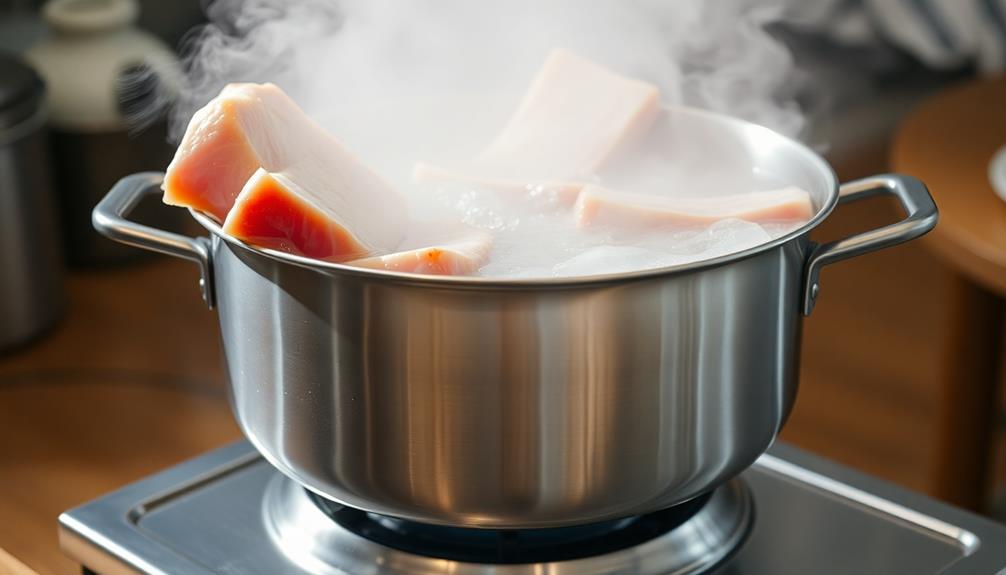
The first step in the cooking process is to blanch the pork belly chunks in boiling water. This important step helps to remove any impurities or excess fat from the meat, giving you a cleaner, more refined flavor in the final dish.
Simply fill a large pot with water and bring it to a rolling boil over high heat. Once the water is bubbling vigorously, carefully add the sliced pork belly pieces. Let them soak for about 2 to 3 minutes, then use a slotted spoon to scoop them out and transfer them to a clean bowl or plate.
Don't worry if the pork looks a bit pale and bland at this stage – the real magic will happen during the next steps of the cooking process. With the pork belly now prepped and ready, you can move on to the next exciting phase of this delicious recipe!
Step 3. Caramelize Pork Belly in Skillet

With the pork belly now prepped and ready, grab a large, heavy-bottomed skillet and place it over medium-high heat.
Once the skillet is nice and hot, add a generous drizzle of oil and let it heat up for a minute or two.
Now, carefully add the blanched pork belly slices to the pan, making sure they don't overlap.
You'll want to let them sizzle and brown for about 2-3 minutes per side, turning them occasionally with tongs.
As the pork sears, you'll start to see the edges turn golden and crispy – that's exactly what you're going for!
Keep an eye on them, adjusting the heat as needed to prevent burning.
Once both sides are beautifully caramelized, transfer the pork to a plate and set it aside.
Don't worry, we're not done yet – there are still a few steps to go before this delicious pork belly is ready to enjoy!
Step 4. Simmer Pork in Aromatic Liquid
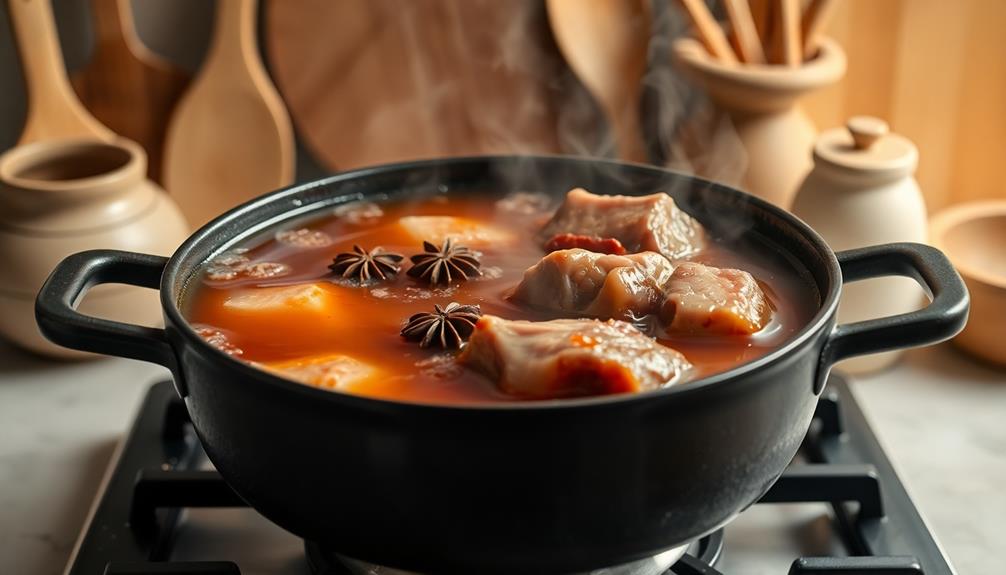
Next, add the caramelized pork belly slices to a Dutch oven or large, heavy-bottomed pot.
Pour in enough water or broth to just cover the pork. Toss in some fragrant ingredients like star anise, cinnamon sticks, cloves, and ginger slices. The pungent aroma will make your mouth water!
To complement your meal, consider serving it with a soothing cup of herbal tea, as many varieties can aid in digestion and enhance your dining experience, such as herbal teas with digestion benefits.
Bring the liquid to a boil, then reduce the heat to a gentle simmer. Let the pork slowly braise for about an hour, or until it's meltingly tender. The longer you simmer it, the more the flavors will blend together.
Be patient – it's well worth the wait! Occasionally, skim any foam or fat that rises to the surface. This will keep your dish nice and clean.
When the pork is super soft, you're ready for the next step. Get ready to experience the deep, rich flavors of this classic Chinese dish!
Step 5. Garnish With Green Onions
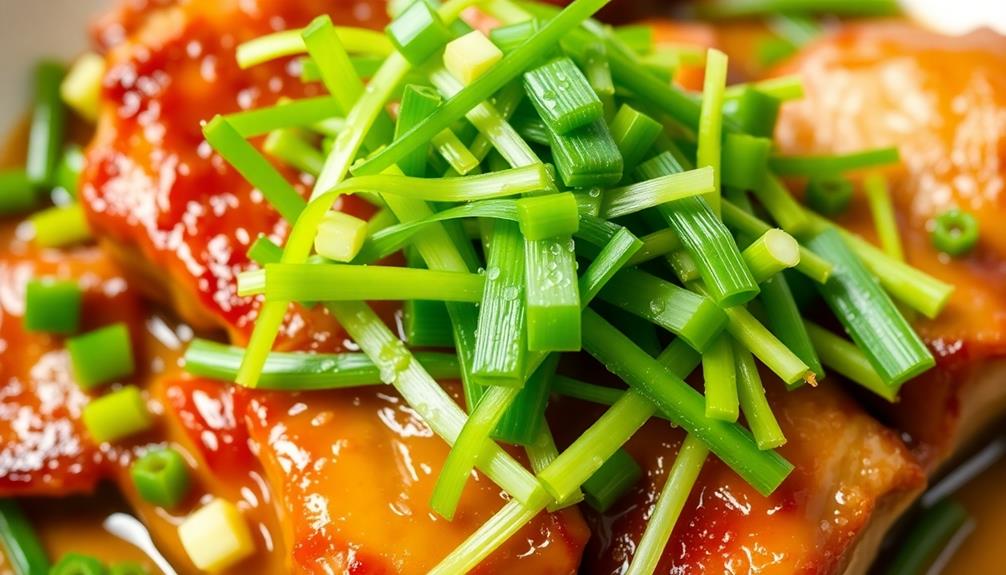
Finely slice some green onions to garnish the tender, red-braised pork belly. You'll want those vibrant, green slices to create a colorful contrast against the rich, caramelized meat. Sprinkle them generously over the top – the fresh, oniony flavor will perfectly complement the savory-sweet pork.
Don't be shy with the green onions! The more, the merrier. They'll add a lovely crunch and brightness to each bite. Plus, the pop of green makes the dish look extra appetizing. Imagine how nice those slender green onion pieces will look, nestled among the shiny, reddish-brown pork cubes.
Once you've added the green onions, your red-braised pork belly is ready to serve. Scoop it up and enjoy the delightful interplay of flavors and textures. The tender pork, the aromatic cooking liquid, and the crisp green onions – it's a harmony of yum that's sure to delight your taste buds.
Final Thoughts
Ultimately, the essence of this red-braised pork belly dish lies in its harmonious balance of flavors and textures. The tender, melt-in-your-mouth pork, combined with the rich, caramelized sauce, creates a truly irresistible experience.
The vibrant green onions you sprinkled on top not only add a pop of color but also a delightful crunch, complementing the dish perfectly.
As you savor the final bites, you can't help but feel a sense of accomplishment. This recipe has allowed you to explore the depths of Chinese cuisine and expand your culinary horizons.
The techniques you've learned, from searing the pork to expertly reducing the sauce, will undoubtedly serve you well in future culinary adventures.
Frequently Asked Questions
Is Red-Braised Pork Belly Suitable for Vegetarians?
No, red-braised pork belly is not suitable for vegetarians. Pork belly is a type of meat, and the dish is prepared using animal-based ingredients, making it unsuitable for those following a vegetarian diet.
Can I Substitute the Pork Belly With Another Cut of Meat?
You can absolutely substitute the pork belly with another cut of meat. Try using chicken thighs, beef brisket, or even tofu for a vegetarian option. The key is to adjust the cooking time accordingly.
How Long Can the Dish Be Stored in the Refrigerator?
Stored leftovers can typically last 3-4 days in the refrigerator. Be sure to refrigerate the dish in an airtight container as soon as it's cooled down. This will help preserve the flavors and prevent spoilage.
Can I Use a Slow Cooker Instead of a Stovetop?
You can absolutely use a slow cooker instead of a stovetop. The slow cooking process will infuse the flavors and tenderize the meat, just like on the stovetop. Give it a try and see how it turns out!
Does the Dish Contain Any Gluten or Nut Ingredients?
The dish does not contain any gluten or nut ingredients. It's a gluten-free and nut-free recipe, so you don't have to worry about those dietary restrictions when preparing it.
Li Wei is an authentic Chinese cooking expert specializing in regional and classic Chinese dishes. From hand-pulled noodles to delicate dim sum and traditional stir-fries, his culinary expertise showcases the variety of Chinese cuisine. Li Wei’s recipes emphasize simplicity, tradition, and rich, flavorful sauces.
Chinese Cuisine
Chicken Feet (Dim Sum Style)
You’ll be surprised at the umami flavor and satisfying texture of these Cantonese dim sum delicacies – learn how to prepare chicken feet like a pro.

Chicken feet are a delightful Cantonese dim sum delicacy that have been enjoyed for centuries! These savory nuggets start with a good boiling to make them nice and tender. Then, you'll sauté some garlic and ginger, add soy sauce and spices, and braise the feet until they're fork-tender. The result is a flavorful, chewy treat that's high in collagen – perfect for your skin and joints. While they may seem daunting at first, chicken feet offer a unique eating experience that'll have you exploring more of the diverse culinary traditions across Asia. Want to learn how to prepare them like a pro?
Key Takeaways
- Chicken feet have been a staple in Cantonese dim sum for centuries, showcasing resourcefulness and respect for ingredients in Cantonese culinary culture.
- The dish involves simmering, braising, and sautéing chicken feet with key ingredients like chicken stock, soy sauce, and spices for a flavorful and tender result.
- Chicken feet offer a unique texture with cartilage and skin, providing an interesting chewing experience and promoting shared dining experiences in dim sum settings.
- Chicken feet are high in collagen, beneficial for skin and joint health, and low in calories compared to other meat options.
- Chicken feet are increasingly available in Asian grocery stores and restaurants, gaining popularity among adventurous eaters and foodies as a delicacy.
History
Dim sum, the Cantonese culinary tradition, has long been intertwined with the humble chicken foot. This unassuming part of the bird has been a beloved component of the dim sum experience for centuries, with its unique texture and savory flavor contributing to the vibrant and diverse flavors of this shared dining style. What are dim sum dishes, you ask? Dim sum dishes are a variety of small, bite-sized portions of food served in steamer baskets or small plates, typically enjoyed with tea. Chicken feet are often braised in a savory sauce, resulting in a gelatinous and tender texture that is both satisfying and flavorful. While it may not be everyone’s cup of tea, chicken feet remain a staple and iconic dish in the world of dim sum.
The origins of chicken feet in dim sum can be traced back to the Cantonese region of China, where resourcefulness and a reverence for all parts of the animal have long been hallmarks of the local cuisine.
As dim sum evolved from a simple teahouse snack into the elaborate, family-style feasts we know today, the chicken foot became an integral part of the experience, showcasing the ingenuity and respect for ingredients that define Cantonese culinary culture. The chicken foot, with its delicate texture and ability to soak up flavors from the surrounding ingredients, is often seen as a symbol of resourcefulness and sustainability in Chinese cuisine. In the same way, the delicious beef wellington recipe highlights the artistry and skillful techniques that have been passed down through generations. Both dishes exemplify the creativity and attention to detail that are the hallmarks of Cantonese cooking. While the chicken foot may be an acquired taste for some, it remains a beloved delicacy that reflects both history and innovation, much like other time-honored dishes that bring families together. Similarly, festive treats like the **reindeer chow recipe for Christmas** evoke a sense of tradition and communal joy, combining simple ingredients to create something special. Together, these diverse culinary practices—from dim sum to holiday confections—underscore the universal language of food, where creativity and cultural identity are always at the forefront.
Today, the chicken foot remains a beloved and iconic dim sum dish, beloved by locals and visitors alike who relish the opportunity to savor this unique and flavorful delicacy.
Recipe
Chicken feet are a beloved delicacy in Chinese cuisine, particularly in the dim sum tradition. When cooked properly, these seemingly unassuming ingredients transform into a flavorful and textural delight. The key to succulent chicken feet lies in a careful preparation process that involves braising and simmering to tenderize the tough cartilage and skin.
Dim sum-style chicken feet are typically served as bite-sized morsels, often accompanied by a zesty dipping sauce that complements the savory, slightly gelatinous texture. The dish isn't only a culinary experience but also a cultural one, as it has been a staple of Cantonese cuisine for generations.
Ingredients:
- 1 lb chicken feet, cleaned and trimmed
- 2 cups chicken stock
- 1/4 cup soy sauce
- 2 tablespoons rice vinegar
- 1 tablespoon brown sugar
- 3 cloves garlic, minced
- 1-inch piece fresh ginger, peeled and sliced
- 2 green onions, sliced
- 1 teaspoon sesame oil
- 1/2 teaspoon white pepper
Instructions:
In a large pot, combine the chicken feet, chicken stock, soy sauce, rice vinegar, brown sugar, garlic, and ginger. Bring the mixture to a boil, then reduce the heat and simmer for 1-1.5 hours, or until the chicken feet are tender and the skin is gelatinous.
Remove the pot from heat, stir in the green onions and sesame oil, and season with white pepper. Serve the chicken feet warm, with the cooking liquid drizzled over the top, along with your desired dipping sauce.
Tips:
When selecting chicken feet, look for those that are plump and free of blemishes. It's important to clean and trim the feet thoroughly before cooking to remove any excess skin or debris.
Additionally, be patient during the simmering process, as it may take some time for the tough cartilage to become tender and the skin to develop the desired gelatinous texture.
Cooking Steps
Okay, let's get cooking!
First, you'll boil the chicken feet in water to tenderize them. After that, drain and rinse the feet to get rid of any gunk.
Next, you'll sauté some garlic and ginger in a pan, then add soy sauce and other seasonings.
Step 1. Boil Chicken Feet in Water

To begin, start by placing the chicken feet in a large pot and covering them with an ample amount of water.
You'll want to make sure the water level is at least an inch above the chicken feet. Now, turn on the heat and bring the water to a boil.
Once it's bubbling away, let the chicken feet simmer for about 45 minutes to an hour. This lengthy boiling time helps to soften the tough, leathery skin and release the natural gelatin from the bones.
As the chicken feet cook, you'll notice the water turning a cloudy, opaque color. This is a good sign – it means all the collagen and nutrients are being drawn out of the feet and into the broth.
Feel free to skim off any foam or impurities that rise to the surface. When the time is up, carefully remove the pot from the heat and let the chicken feet cool slightly before handling.
They're now ready to be seasoned and served as part of your delicious dim sum feast!
Step 2. Drain and Rinse Chicken Feet

Once the chicken feet have finished simmering, carefully drain them in a colander.
You'll want to make sure all the water has gone, so gently shake the colander to help it along.
Next, rinse the chicken feet under cool running water. This will wash away any remaining scum or impurities.
As you run your fingers through the feet, you might notice some small, hard nubs – these are the toe nails, and you'll want to remove them.
Simply pinch each one and pull it off.
Now your chicken feet are ready for the next step! Aren't they looking cleaner already?
With the water drained and the feet rinsed, you're one step closer to enjoying delicious, authentic dim sum.
Keep up the good work – the tasty payoff is almost here!
Step 3. Sauté Garlic and Ginger

With the chicken feet now washed and ready, you'll want to start by sautéing the garlic and ginger. This is a crucial step that will infuse your dish with mouthwatering aromas and flavors.
Heat a large skillet or wok over medium heat and add a couple tablespoons of oil. Once the oil is shimmering, toss in the minced garlic and grated ginger. Stir-fry for about a minute, until the garlic becomes fragrant and starts to turn golden. Be careful not to let it burn, as that can make the flavor bitter.
Next, add the blanched chicken feet to the pan. Toss everything together, making sure the feet are well coated in the garlicky-ginger oil. Let them sizzle and brown for a few minutes, stirring occasionally.
This will help develop a delicious crust on the outside of the chicken feet. Soon, your kitchen will be filled with the most tantalizing scents, getting you excited for the flavorful dim sum dish to come.
Step 4. Add Soy Sauce and Seasonings

After the chicken feet have had a chance to brown, it's time to add the soy sauce and other seasonings.
First, pour in a few tablespoons of soy sauce – this will give the chicken feet a lovely, deep brown color and a savory flavor. Don't be shy with the soy sauce, as it's a key ingredient that really makes the dish pop.
Next, sprinkle in a pinch or two of white pepper. The peppery kick will complement the salty soy sauce perfectly.
You can also add a dash of sesame oil, which will add a nutty aroma and a silky mouthfeel.
Step 5. Braise Chicken Feet Until Tender

Having added the soy sauce and seasonings, it's time to braise the chicken feet until they become fork-tender.
First, place the seasoned chicken feet in a large pot and cover with water. Bring the pot to a boil over high heat, then reduce the heat to medium-low and let the feet simmer for 45 minutes to an hour.
You'll know they're done when you can easily pierce them with a fork. The long cooking time helps break down the tough connective tissues, making the feet wonderfully soft and gelatinous.
Once they're tender, you can remove the feet from the pot and serve them up hot. Don't forget to provide plenty of napkins – these juicy chicken feet can get a bit messy to eat!
With their savory, umami-packed flavor, these braised chicken feet make a truly delightful dim sum treat. Enjoy exploring this unique and tasty part of the chicken.
Final Thoughts
Though chicken feet dim sum may not be for everyone, the unique flavors and textures it offers can be a delightful experience for those willing to try it. The braise process transforms the tough, rubbery texture into something surprisingly tender and succulent. The aromatic spices and sauces infuse the chicken feet with a robust, savory taste that's unlike anything else.
For those feeling adventurous, chicken feet dim sum is a fun way to expand your culinary horizons. The cartilage and skin provide an interesting chewing experience, and the subtle flavors make each bite an enjoyable discovery.
Don't be afraid to get your hands a little messy – that's part of the fun! With a bit of practice, you'll be expertly plucking the meat off the bones in no time.
Whether you're a seasoned dim sum enthusiast or a curious newcomer, chicken feet offer a unique and tasty addition to your culinary adventures. Give them a try and see for yourself the pleasures of this unique dim sum delicacy.
Frequently Asked Questions
Are Chicken Feet Considered a Delicacy?
You might consider chicken feet a delicacy, as they're a popular appetizer in certain Asian cuisines. While they may not be everyone's cup of tea, they're prized for their unique texture and flavor.
Can I Find Chicken Feet at Regular Grocery Stores?
You can usually find chicken feet at regular grocery stores, though their availability may vary by location. Check the poultry section or ask a store employee for assistance in locating them.
How Do I Clean and Prepare Chicken Feet?
You can clean and prepare chicken feet by rinsing them thoroughly, trimming any excess skin or nails, and boiling them for about 30 minutes to tenderize the texture. Then, you're ready to use them in your desired recipe.
What's the Difference Between Cantonese and Sichuan-Style Chicken Feet?
The key difference between Cantonese and Sichuan-style chicken feet lies in the flavor profile. Cantonese-style is typically more mild and savory, while Sichuan-style features a bold, spicy kick from the use of Sichuan peppercorns and chili peppers.
How Long Do I Need to Cook Chicken Feet?
You'll need to simmer the chicken feet for about 1-2 hours until they're tender and the cartilage can be easily chewed. The longer they cook, the more the tough connective tissues will break down.
Li Wei is an authentic Chinese cooking expert specializing in regional and classic Chinese dishes. From hand-pulled noodles to delicate dim sum and traditional stir-fries, his culinary expertise showcases the variety of Chinese cuisine. Li Wei’s recipes emphasize simplicity, tradition, and rich, flavorful sauces.
-

 Southern Comfort Food1 month ago
Southern Comfort Food1 month agoCheese Straws
-
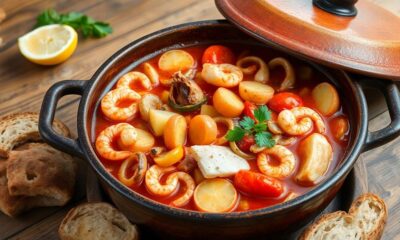
 Brazilian Cuisine1 month ago
Brazilian Cuisine1 month agoCaldeirada
-

 Southern Comfort Food1 month ago
Southern Comfort Food1 month agoCreamed Corn
-

 Brazilian Cuisine1 month ago
Brazilian Cuisine1 month agoChicken in Brown Sauce
-

 Brazilian Cuisine1 month ago
Brazilian Cuisine1 month agoTacacá
-

 Southern Comfort Food1 month ago
Southern Comfort Food1 month agoSquash Casserole
-

 Ethiopian Cuisine1 month ago
Ethiopian Cuisine1 month agoBuna (Coffee)
-

 Southern Comfort Food1 month ago
Southern Comfort Food1 month agoChocolate Gravy








